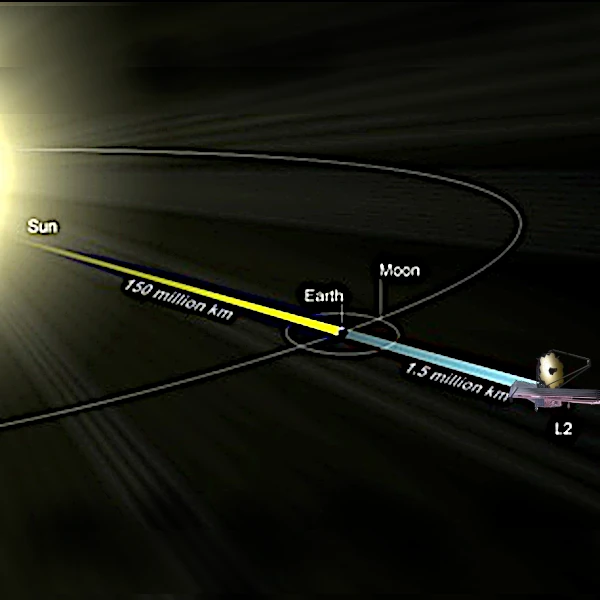
The James Webb Space Telescope (JWST) is the most powerful instrument ever launched into space to observe the universe in the infrared domain. Successor to the Hubble telescope, it represents a technological leap by capturing extremely low-energy photons emitted by cosmic objects billions of light-years away. Thanks to its segmented primary mirror measuring 6.5 meters in diameter and its complex deployment at the Lagrange point L2, James Webb observes the first galaxies formed after the Big Bang, revealing an era of the universe previously invisible.
The Lagrange point L2, located about 1.5 million kilometers from Earth in the direction opposite to the Sun, provides a stable and privileged orbital environment for infrared observation. This gravitational equilibrium point allows JWST to maintain a nearly fixed position relative to Earth and the Sun, simplifying the thermal and energy management of the satellite. By orbiting around L2 (on a halo orbit), the telescope can continuously orient its sunshield toward the Sun, Earth, and Moon, which all remain on the same side. This configuration is crucial to passively cool the scientific instruments to cryogenic temperatures (< 50 K), essential to prevent the telescope’s own heat from masking the faint infrared signal from the cosmos.
Moreover, unlike Hubble’s low Earth orbit (about 540 km to 560 km), the L2 location allows JWST to minimize occultations and observation interruptions, offering a much more stable and continuous view of the sky. It is also a strategic position to limit interference from Earth's infrared emissions, while maintaining regular communication with ground stations via an Earth-pointed antenna. In summary, L2 combines thermal stability, maximum visibility, and energy efficiency—three essential conditions for JWST’s scientific mission.
One of the major challenges of the JWST is its operation in the thermal infrared, requiring a cryogenic environment. Its five-layer thermal shield protects the instruments from solar and terrestrial radiation, lowering their temperature below 50 K. The four scientific instruments on board — NIRCam, NIRSpec, MIRI, and FGS/NIRISS — cover a wide spectral range from 0.6 to 28 microns. This spectrum allows the detection of chemical signatures of molecules in the atmospheres of exoplanets, as well as probing protoplanetary disks and star formation through interstellar clouds.
Unlike Hubble, which observes primarily in the visible and ultraviolet domains, James Webb is an infrared telescope. This means it is designed to detect wavelengths between approximately 0.6 and 28 microns, well beyond what the human eye can perceive. At these wavelengths, any warm body emits its own infrared radiation, including the telescope itself. To avoid being blinded by its own heat, JWST must therefore operate in an extremely cold environment.
This need led to the design of an unprecedented passive cryogenic system. A five-layer sunshield, the size of a tennis court, blocks light from the Sun, Earth, and Moon. This thermal shield gradually reduces the temperature of the telescope, reaching about 50 K (-223 °C) on the instrument side. For the MIRI (Mid-Infrared Instrument), which operates between 5 and 28 microns, a mechanical cryocooler further lowers the temperature to 6.7 K.
This extreme cooling allows JWST to detect infrared photons emitted by the coldest and most distant objects in the universe, such as primordial galaxies, protoplanetary disks, and the atmospheres of exoplanets. Without this high-precision cryogenics, these signals would be lost in the thermal noise of the telescope itself.
From its first observations, James Webb has revealed high redshift galaxies \( z > 10 \), challenging galaxy formation models. It has also enabled the spectroscopic detection of molecules such as water, carbon dioxide, or methane in the atmospheres of hot exoplanets, opening a new era for astrobiology. By revealing a large-scale structure of the very young universe, JWST acts as a time machine, providing access to the epochs when light began to propagate freely.
The redshift (\( z \)) is a measure of the stretching of light wavelengths due to the expansion of the universe. The farther an object is, the more its light is stretched toward the red (longer wavelengths). For an object with redshift \( z \), the observed wavelength \( \lambda_{\text{obs}} \) is related to the emitted wavelength \( \lambda_{\text{em}} \) by:
\[ \lambda_{\text{obs}} = (1 + z) \cdot \lambda_{\text{em}} \]

One of the emblematic examples of the optical power of the James Webb Space Telescope is the new image of the Pillars of Creation in the Eagle Nebula. On the left, the image obtained in 2014 by Hubble in visible light shows columns of cold gas and dust, a famous silhouette of star formation. On the right, the 2022 image taken by JWST in near-infrared (NIRCam instrument) reveals a completely different scene: the penetration of infrared radiation through the dust reveals hundreds of red stars in the process of formation, previously invisible. The superior angular resolution of JWST, combined with its infrared sensitivity, thus allows exploring the interior of these dense molecular clouds and following the process of star birth with unprecedented precision.
The JWST is more than a telescope: it is an optical revolution. It condenses decades of research in optical, thermal, and orbital engineering. Its precision, sensitivity, and stability offer scientists a new way of reading the cosmos. By revealing what visible light cannot show, James Webb extends our vision to the confines of space-time, where our Universe was born.